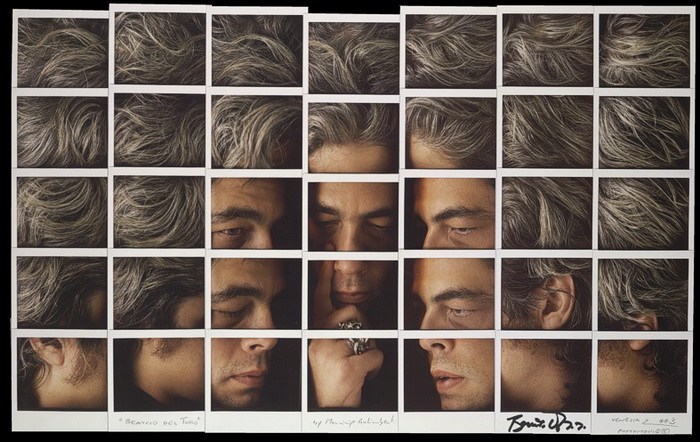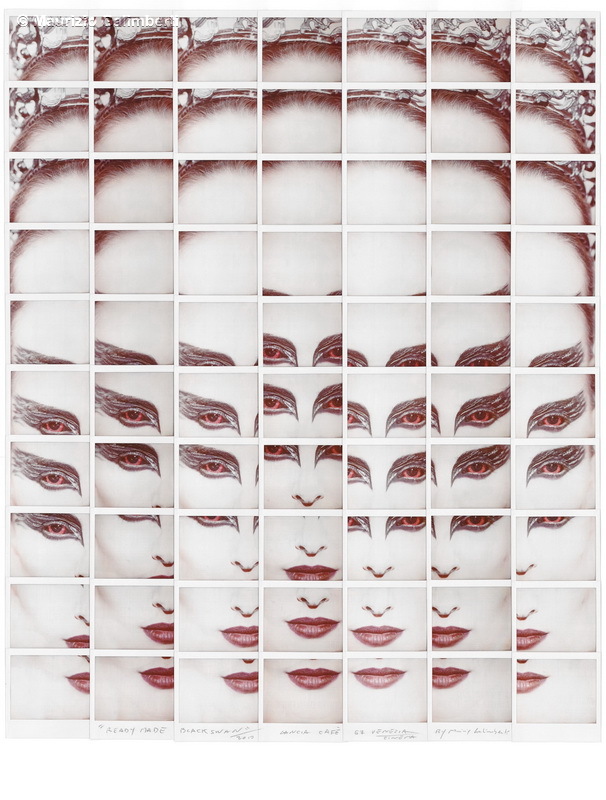Liquid Light is an enlargement-speed, silver-halide photographic emulsion for making salon-quality prints on any material. Processing is with standard paper developer and fixer. Liquid Light is non-toxic and is unique in containing no phenol or other solvents, and can be used safely in any darkoom. Follow these instructions carefully to obtain durable, archivally-permanent prints.
SURFACE PREPARATION
Paper and fabric do not need a pre-coat because they are porous enough to anchor the emulsion, so Liquid Light can be coated directly onto them. (Unwashed fabrics, including raw artists' canvas should be washed and dried before coating.)
Paper and fabric do not need a pre-coat because they are porous enough to anchor the emulsion, so Liquid Light can be coated directly onto them. (Unwashed fabrics, including raw artists' canvas should be washed and dried before coating.)
Other materials-- metal, plastics, wood, etc.-- need an oil-based pre-coat for good adhesion and to prevent discoloration. For a transparent pre-coat, use glossy polyurethane varnish. For an opaque pre-coat, use oil-base, or alkyd, primer. Both are available at paint and hardware stores. (Oil-base coatings are those that the label says can be thinned with mineral spirits. Do not use water-base coatings or acrylic gesso, aerosol spray coatings, satin or matte varnishes, artist's oil paints, damar varnish, lacquer or shellac. They may be softened by developer.) Note to artists: If canvas has been primed with water-base gesso, it should be given a topcoat of alkyd primer or glossy polyurethane.
Glass and glazed ceramics only: These also require a pre-coat for adhesion, such as polyurethane, but a better alternative is a gelatin precoat or traditional photographic "subbing" solution, which fuses the photographic emulsion to the glass. Subbing works only with mineral-base materials like glass and chinaware, glazed tiles, ceramics and fired porcelain. Do not use on plastics, metals, or other materials-- use polyurethane. For a guide to the subbing procedure, see "Subbing" in Table of Contents.
COATING & EXPOSING LIQUID LIGHT
Safelight: Use a medium amber, dark yellow or light red safelight when handling Liquid Light. Because it is relatively slow, Liquid Light can tolerate a large amount of safelight brightness and exposure time without fogging. (For maximum safelight output, a low-pressure sodium-vapor lamp with amber filter can be used.)
Safelight: Use a medium amber, dark yellow or light red safelight when handling Liquid Light. Because it is relatively slow, Liquid Light can tolerate a large amount of safelight brightness and exposure time without fogging. (For maximum safelight output, a low-pressure sodium-vapor lamp with amber filter can be used.)
At room temperature, Liquid Light emulsion is a solid gel. Before use, plunge the bottle into a container of hot water (130 deg.F or higher) until the emulsion turns liquid. This happens at about 115 deg.F or 46 deg.C. (A microwave oven can be used if care is taken not to overheat the emulsion. Maximum time: 20 to 30 seconds on "high".) Do not shake the bottle, as bubbles may form. The emulsion is uniform throughout, so it is not necessary to melt the entire contents if only a portion is being used. Use containers of glass, plastic, enamel or stainless steel; plain steel, brass, copper, aluminum and other metals will react with the silver compounds in the emulsion to form black specks.
Apply Liquid Light with a brush, sponge, paint applicator, paint roller, spray, or by flowing on and draining off the emulsion. If spraying, be sure the spraygun has no brass parts. Dilute the emulsion with warm water if needed. Porous materials need two or more coats. At the same time, coat a few pieces of paper or index cards to serve as test strips for correct exposure.
Small areas: The easiest way to coat is to pour on a surplus of emulsion, spread it quickly with a fingertip and pour the surplus emulsion back in the bottle, leaving enough emulsion to make an opaque white coat. After coating, cool air will help to set up the emulsion. Use a fan if available. After a few minutes, the emulsion will set up or become sticky and can be exposed and and developed. Or it can be dried and put away for future use.
Large areas: Keep the emulsion warm in a container of hot water so that it stays liquid as long as necessary. Use a soft brush or other means of spreading it. After the emulsion has been coated, put a fan on it a few minutes, until it becomes sticky, then give a second coat at right angles to the first. Allow the second coat to set up or become sticky, then expose and process it, or dry it and set aside for future use. If dried, it must be dried thoroughly under low humidity and with circulating air, not in a closed box.
Exposing: Liquid Light exposure varies with age, so differently dated batches may exhibit different sensitivity. A suggested trial exposure time for an enlarger at full aperture is 20 seconds for an 8x10 inch print. Determine the exact exposure with a test strip.
Using a projector: For large prints such as wall murals, artist's canvas and other oversized surfaces when an enlarger does not give enough light, a slide projector can be used. To limit light output and sharpen the image, tape a piece of black paper having an approximately 3/8 inch hole over the front of the projector lens. Or use a polarizing filter. Because of the high light output of a slide projector, color negatives can also be used to yield black-and-white prints.
PROCESSING LIQUID LIGHT
Develop with paper developer like Kodak Dektol at the recommended working strength of one part developer to two parts of water. Develop in a tray like a conventional print, or if the print is too large, by a sponge or brush liberally wetted with developer. (For large surfaces, even-out development by first wetting the surface with cool water.) For large prints and canvases, a temporary "tray" can be made from a larger-size primed stretched canvas containing the processing solutions.
Develop with paper developer like Kodak Dektol at the recommended working strength of one part developer to two parts of water. Develop in a tray like a conventional print, or if the print is too large, by a sponge or brush liberally wetted with developer. (For large surfaces, even-out development by first wetting the surface with cool water.) For large prints and canvases, a temporary "tray" can be made from a larger-size primed stretched canvas containing the processing solutions.
Shortstop: After developing, do not use a water rinse or an acid shortstop, which will soften the emulsion. Instead, use a small amount of fixer as a shortstop (worn-out, discarded fixer is okay.) A few seconds in this bath will neutralize the developer.
Fixing: For best results, use a powdered hardening fixer like Kodak Fixer. Avoid liquid or rapid fixers, which can bleach the image and do not effectively harden the emulsion. Fix until all the chalky white areas of the emulsion have turned transparent and it becomes tough and leathery to the touch-- at least 10 minutes. Note: the function of a fixer is to wash away the unused silver compounds; therefore, the fixer should be used generously, with frequent agitation.
Wash ten minutes in cool running water after hardening is complete. Liquid Light prints wash easily because water easily penetrates the emulsion. A hypo eliminator or hypo clearing agent can be used if desired. After drying, a wrinkled print can be flattened by pressing with a flatiron or dry-mount press on low-heat setting.
Protect the surface only if a harsh environment exists or it will be shown outdoors. Normally, Liquid Light requires no protective coating. For best protection, coat the dried print with a water-based polyurethane finish. (Do not confuse with the oil-based polyurethane used as a pre-coat. After Liquid Light has been processed and dried, the choice is much greater and virtually any type of oil, water, or solvent-based finish can be used as a protective finish.)
Adding color: The color and texture of the surface that has been coated are visible through the transparent areas of a Liquid Light print, so extra colors are often not used. Liquid Light prints can be toned with conventional sepia or selenium print toners or with Rockland Selectachrome and Printint toners. Liquid Light can also be hand-colored with artist's oil paints, photographic oils, water-based acrylics, or virtually any other type of paint.
CLEANUP
Liquid Light emulsion contains no hazardous chemicals and requires no special precautions for use except when spraying. If spraying, use adequate ventilation and wear a respirator. Emulsion that has not been hardened by fixing can be removed from surfaces with hot water. Fixed, hardened emulsion can be dissolved with dilute solutions of household bleach like Clorox or Purex. © Rockland Colloid
Liquid Light emulsion contains no hazardous chemicals and requires no special precautions for use except when spraying. If spraying, use adequate ventilation and wear a respirator. Emulsion that has not been hardened by fixing can be removed from surfaces with hot water. Fixed, hardened emulsion can be dissolved with dilute solutions of household bleach like Clorox or Purex. © Rockland Colloid


